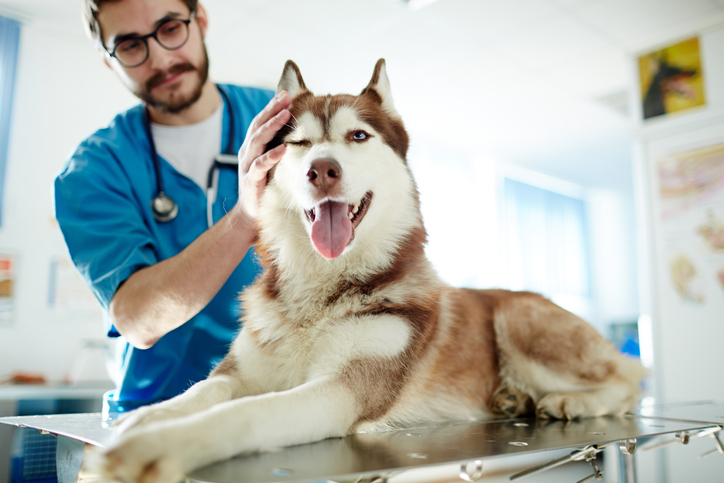How do I know if my dog has arthritis?
19th September, 2019

Is your four-legged friend struggling to get down from the sofa? Perhaps they don’t run to greet you as you open the front door anymore? Your dog could be suffering from arthritis, which causes inflammation of the joints and limits their mobility.
Like humans, dogs are susceptible to arthritis, also known as a degenerative joint disease (DJD).
However, canine arthritis is particularly common, affecting 4 out of 5 older dogs. It can also affect younger, more active canines, depending on their breed, weight and general health.
Osteoarthritis is the most common cause of chronic pain in canines, and this affects multiple joints at any one time.
It can disrupt everyday life for your dog, due to the abnormal rubbing that takes place between joints.
The most common areas affected by arthritis in canines are the elbows, hips, knees, lower back and wrists.
While arthritis cannot be cured, you can help your dog with the symptoms.
Once the cartilage is damaged, a full recovery is rare – however with proper treatment and care, you can still do your best to make sure they remain a happy hound.
We can empathise with the discomfort caused by arthritis, so it’s important to consider how this might be affecting your pet.
This way, you can begin treatment early, halt the progression of the disease and preserve their quality of life.

What causes arthritis in dogs?
Just like us humans, the insides of a dog’s joints are protected by a smooth layer of cartilage that acts as a lubricant when the joints rub together or move back and forth.
If it’s damaged by arthritis, it can cause chronic friction between them.
This, in turn, encourages new bone growth to develop around the joints, also known as bone spurs, which is why bones become so stiff.
Dogs typically experience arthritis in the same way humans do and it’s most prevalent in older dogs as they age. However, it can affect your pooch at any age due to a variety of factors:
The size and breed of the dog
Larger dogs tend to experience symptoms of arthritis more often than smaller breeds, such as German Shepherds, Labrador Retrievers, Rottweilers and Golden Retrievers.
Being overweight
This can cause stress on the joint, and therefore increase wear and tear on joint cartilage.
Genetic factors
Arthritis may arise as a result of hereditary factors within certain breeds.
Trauma
For example, if they have sustained a joint injury early in life.
Abnormal joint growth
Abnormalities inherited at birth can include hip dysplasia, where the joints have not developed properly.
Bacterial infections
There are various forms of arthritis in dogs, and septic arthritis is caused by a bacterial infection typically affecting a single joint.
Lyme disease
Some tick-borne illnesses such as Lyme can cause mobility issues and arthritis in dogs.
Issues with the immune system
Another form of canine arthritis is immune-mediated polyarthritis, which is when the immune system cannot properly fight off infections and causes inflammation of the joints.
What are the symptoms of arthritis in dogs?

There are a number of tell-tale signs to look out for if you’re concerned that your dog might be suffering from arthritis. It can affect them both emotionally as well as physically, so keep an eye out if they’re exhibiting any of the following behaviours:
They’re limping
If you see that your pet is favouring one side of their body to walk around, it might indicate that one or more joints are arthritic. Eventually, limping will become more apparent as their joints become stiffer.
Their posture has changed
Arthritis is common for dogs in the lower back, so if you notice that they are sagging in the back area, it could be a sign of arthritis.
They’ve gained weight
An inability to exercise inevitably brings with it subsequent weight gain. This can be controlled by adhering to a proper diet plan.
They’re suffering from fatigue and lethargy
Alongside limping and having trouble walking, they will be resting more often than usual and might suffer from a lack of energy.
If you notice that your pup lacks the energy to do their favourite things such as running around, jumping up and going for walkies, then it might be that they’re struggling with arthritic pain.
They’re sleeping more than usual
If your pooch is snoozing more than they normally would, they could be tired from exerting energy to move stiff joints.
They’re having difficulties moving
If they’re not as energetic when getting up after lying down, this could be a sign of muscular stiffness from arthritis.
Similarly, if they’re reluctant to climb up and down the stairs, then this could also be an indication that they’re lacking joint mobility.
They’ve lost muscle mass
Reduced physical activity can cause muscle loss in your dog. Larger dogs are more prone to muscular atrophy as a result of arthritis, although it can still occur in smaller dogs.
If their back legs can no longer support their weight and they begin to favour their front legs, they might have lost some muscle mass from arthritis.
Their appetite has changed significantly
There’s a lot to be said for how a doggy enjoys their food. If they’re not wolfing it down as per usual, then you should monitor their behaviour. It can indicate that they’re distressed or experiencing joint pain.
They’re unexpectedly aggressive or irritable when touched
It’s quite normal that dogs experiencing chronic pain such as arthritis will be more distressed.
This might manifest itself in feeling irritated when petted, particularly in areas where they might be experiencing arthritic pain, such as their lower back.
They might be unexpectedly aggressive towards humans, or other dogs.
They are soiling the house
If your dog is having mobility issues as a result of chronic joint pain, it can be difficult for them to reach the toilet. House soiling can occur and is something to look out for in conjunction with other signs.
If you think they might be suffering from arthritis, get them checked out at the vet for a proper diagnosis.
What do you give a dog for arthritis pain?

If you suspect that your pooch is suffering from arthritis, then your first step of action should be to book an appointment with the veterinarian, who will probably prescribe a special type of anti-inflammatory medicine.
The most important thing to remember is that dogs cannot be treated in the same way as humans can with arthritic pain – so don’t reach into your medicine cabinet to treat them.
There are a series of over-the-counter remedies to help ease the pain for your four-legged friend.
Equally, there is a whole range of homoeopathic remedies and practical solutions that can also work wonders, upon your vet’s recommendation.
The best non-medical options for your dog include:
Dietary adjustments
You should focus on keeping their diet lean if movement is limited. Foods rich in Omega-3 fatty acids like DHA and EPA have been proven to be effective in reducing joint inflammation in dogs.
Weight management
It’s important to monitor how much they weigh, to avoid putting unnecessary stress on your dog’s joints. Some breeds are more prone to weight gain than others, so keep an eye on them.
Appropriate activity and exercise
While mobility might be limited for a dog with arthritis, it’s also important to keep them moving with low-impact exercise to loosen up stiff joints.
Physical rehabilitation
Yes, your hound can reap the benefits of physio, too! There is a whole range on offer for dogs, including canine muscular massage, range-of-motion exercises, and warm water hydrotherapy.
There are even underwater treadmills to help improve the mobility of canines without putting pressure on the joints.
Other non-medical therapies
Dogs suffering from arthritis can also undergo acupuncture to relieve joint pain. There are endless options to explore to improve your pooch’s quality of life.
What can I give my dog for arthritis over the counter?
First things first - never self-diagnose your dog with arthritis. You should always ask for the vet’s advice before purchasing any over-the-counter pain medication, and have it confirmed that it’s indeed degenerative joint disease.
At Purely Pets we actually offer a free, 24-hour vet helpline as part of our dog insurance policies where you can get advice and reassurance if you have any concerns.
If your vet prescribes something for your dog, it’s likely to be one of the following:
Feed supplements
The vet might prescribe your dog a Glucosamine-type supplement for arthritis relief. It’s best used as a long-term treatment, and the earlier you give it to them, the slower onset of arthritis. It can either be taken as Glucosamine or as Glucosamine in combination with Chondroitin Sulfate).
They might also recommend an all-round dietary supplement which provides a range of nutrients.
NSAIDs
For immediate pain relief from arthritis, they may also prescribe your dog NSAIDs, which stand for Nonsteroidal anti-inflammatory drugs.
Cartilage protectors
These are designed to reduce damage exerted on cartilage. They help to promote repair of the joint and replenish synovial fluid.
Should you walk a dog with arthritis?

Yes – moderate, low-impact exercise is encouraged no matter what. This can, in fact, help doggies with arthritis move easier, and also prevents weight gain which can add further stress to their joints.
If your dog has been diagnosed with arthritis, they might not enjoy activities that they previously did, such as high-impact running, jumping or agility games.
However, this is by no means a sign that they should stop exercising altogether.
Take it step-by-step. Instead, the goal should be to increase their heart rate sufficiently so that they remain active.
It’s fundamental that they maintain some form of muscular strength, and that you as their owner do all you can to preserve their remaining mobility.
Try a couple of minutes of gentle playing or walking before initiating a range of low-impact exercises, or short, frequent walks. Gentle exercise or walking can also help to reduce cramp, injury or sprains.
What home remedy can I give my dog for arthritis?
Once it has been confirmed by your vet that your dog has arthritis, the good news is that there are many ways to improve their health and make life easier for them at home.
There’s a lot to be said for natural, anti-inflammatory foods to reduce swelling around the joints affected by arthritis, for example.
Keep a health journal for your canine to figure out which treatments work, and which they’re not so fond of.
Dogs cannot tell you if they’re in pain, so it’s important for you to monitor their behaviour. Here are some of the best things you can do for your dog:
Supportive bed
When it’s time for bed, make sure that they are entirely comfortable with a soft place to sleep. This can prevent lameness from getting worse and helps reduce lethargy in your pooch.
Change exercise routine
Regular exercise should be maintained, but perhaps a few adjustments need to be made to reduce strain on their joints. If you are taking them for long walks, change it for frequent, shorter ones.
Provide anti-inflammatory foods suitable for dogs
When your dog's mobility is limited, their diet should be prioritised. Many anti-inflammatory foods are suitable for humans but toxic to animals – such as garlic or onions. You might be surprised how well dogs with arthritis respond to certain nutritional supplements.
Check out this list of anti-inflammatory foods that are suitable for dogs. Omega-3 is a sure contender for reducing inflammation, so oily fish such as salmon and mackerel will be a welcomed treat for your dog.
Protect your dog against slipping
If you notice that your dog is sliding or falling, you must certainly take steps to prevent this, as it can exacerbate stress on the joints. You can try installing carpet runners or anti slip mats, to prevent an arthritic dog from slipping, particularly on hardwood floors.
Keep nails trimmed
When a dog’s nails are too long, it can affect their skeletal posture and worsen arthritis in the feet. Make sure that they’re always trimmed.
Look into purchasing a mobility device
Look out for whether they’re having trouble walking on their own, or getting in and out of bed. There are various devices on the market nowadays to help promote mobility for your pooch: including slings, wheelchairs, carts, harnesses and ramps.
Protect your pet with dog insurance from Purely Pets
If you’re looking for dog insurance that you can trust, Purely Pets can help you. From our wide range of Lifetime cover available, all of your dog insurance documents are available online so you’re able to manage your policy flexibly, whenever it suits you best.
Additionally, our free 24-hour vet helpline operates 365 days a year, giving you instant access to RCVS (Royal College of Veterinary Surgeons) registered nurses who have at least three years of practical experience.
There’s also no upper age limit at Purely Pets, so if you are thinking of finding pet insurance for your older dog, there are many options available.
Get a quote for dog insurance today, and see how much you could save.
Frequently asked questions
What are the 4 stages of arthritis in dogs?
The first stage of arthritis in dogs is often characterised by mild stiffness and occasional discomfort. At this stage, pet owners may notice that their dog is not as active as usual and may have difficulty getting up or down stairs. It is important to pay attention to these early signs and consult a veterinarian for a proper diagnosis.
As the condition progresses to the second stage, dogs may experience more frequent discomfort and stiffness. They may have difficulty jumping onto furniture or may limp after exercise. It is at this point that pet owners should consider implementing changes to their dog's routine, such as providing joint supplements that your vet may recommend or modifying their exercise regimen.
The third stage of arthritis in dogs is marked by more severe pain and limited mobility. Dogs at this stage may be reluctant to move or may have difficulty getting up after lying down. It is crucial for pet owners to provide additional support and comfort for their dogs, such as providing a soft bed or using ramps to help them navigate stairs.
The fourth stage of arthritis in dogs is the most advanced and debilitating. Dogs at this stage may have difficulty walking or may be unable to bear weight on affected limbs. They may require assistance with daily activities such as eating or going outside. In these cases, it is important for pet owners to work closely with their veterinarian to manage pain and improve quality of life for their beloved pets.
Helpful Pages
Recent Posts

Why do Pugs lick the air?
02/10/24Pet Insurance Quote
- 98% claims paid *
- Claims paid directly to vets
- 24/7 vet video consultations
- Interest free monthly payments



